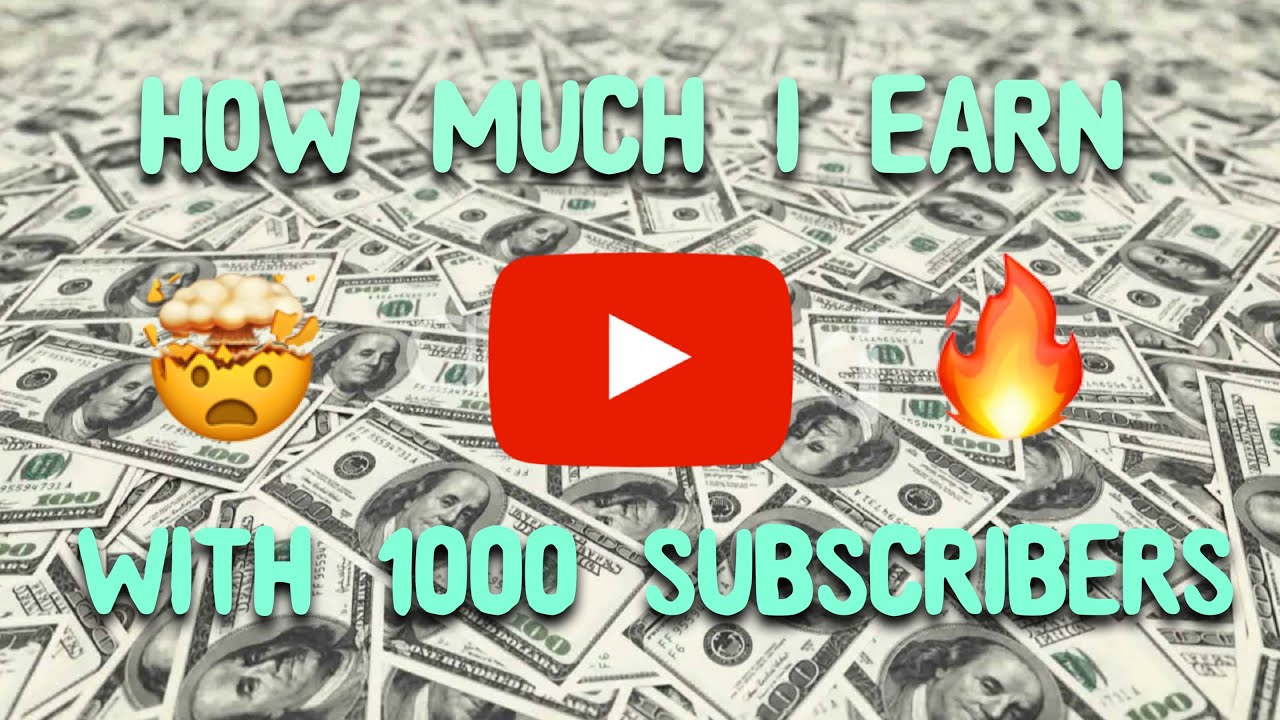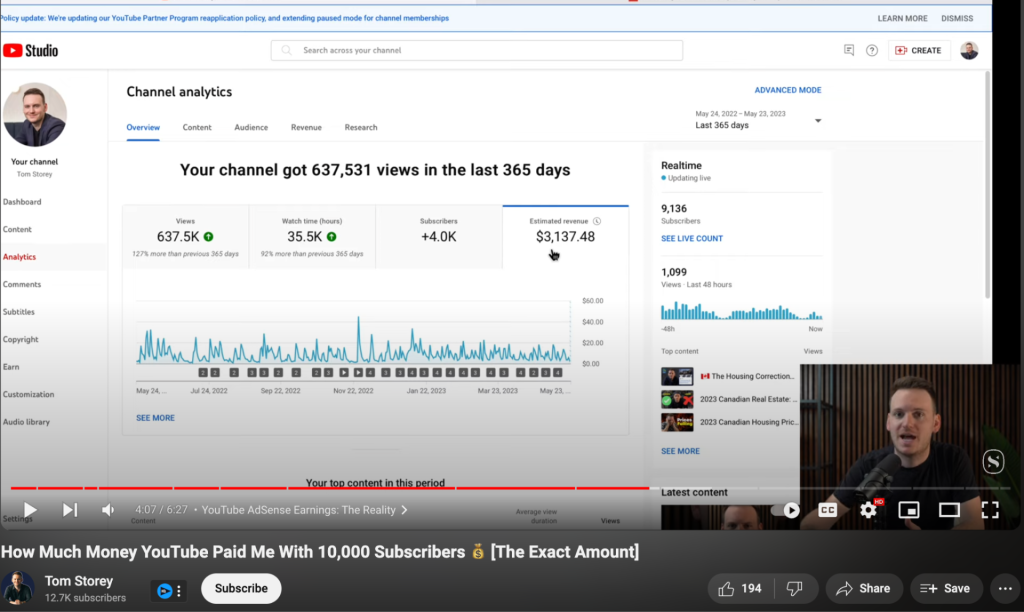So, you’ve been curious about the earnings of YouTubers, especially those who have crossed the coveted milestone of 100,000 subscribers. It’s a significant achievement, and many wonder how this translates to actual income. While the numbers can vary widely based on several factors, it's intriguing to dive into the mechanics behind YouTube earnings and what it truly means for content creators. Let’s unpack this fascinating world of YouTube monetization and explore how these creators make their money.
Understanding YouTube Monetization

YouTube monetization is the process through which creators earn money from their content. If you’re pondering how your favorite YouTubers rake in the cash, here are the primary avenues they explore:
- Ad Revenue: This is the most common method. Videos that are part of the YouTube Partner Program (YPP) can display ads, and creators earn a portion of the income generated when viewers watch those ads. The key metrics that influence ad revenue include:
- CPM (Cost Per Thousand Impressions): This is how much advertisers are willing to pay per 1,000 views. It varies widely based on the niche, time of year, geographic location of viewers, and other factors.
- Watch Time: The longer viewers watch, the better it is for ad revenue. Higher watch time can lead to improved placement and higher CPMs.
- Channel Memberships: For channels with over 30,000 subscribers, creators can offer memberships. Fans pay a monthly fee for perks like exclusive content, badges, and other fun bonuses, providing a steady income stream.
- Sponsorships: Many YouTubers collaborate with brands for sponsored content. This involves promoting a product or service, and the payment can vary dramatically based on the creator’s reach and engagement. A rough estimate for YouTubers with 100,000 subscribers might see sponsorship deals ranging from $1,000 to $5,000 or more per video.
- Merchandise Sales: Creators often launch their own products—be it clothing, accessories, or digital goods. This can be a lucrative revenue stream, especially for those with a dedicated fanbase.
- Affiliate Marketing: By promoting products and including affiliate links in video descriptions, YouTubers can earn a commission on sales generated through those links.
But how do these income streams add up? Let’s break down an example:
| Income Source | Estimated Earnings |
|---|---|
| Ad Revenue (say $5 CPM with 100,000 views per video) | $500 |
| Channel Memberships (100 members at $5/month) | $500 |
| Sponsorships (1 deal per month at $2,000) | $2,000 |
| Merchandise Sales | $300 |
| Affiliate Marketing | $200 |
Total estimated earnings per month: $3,500
Of course, these figures are averages and can vary drastically. Some YouTubers will earn much less, while others with larger audiences and more engaged fans can earn substantially more. The beauty of this platform lies in its flexibility and the potential for exponential growth. It’s not just about the number of subscribers, but the level of engagement and connection with the audience that drives earnings.
Also Read This: How to Burn YouTube Videos to a CD: Step-by-Step Instructions
3. How Subscriber Count Influences Earnings

When it comes to YouTube, having a substantial subscriber count can significantly influence a creator’s earnings. While subscribers aren’t the only factor that determines income, they play a crucial role. So, let’s dive into why subscriber count matters and how it correlates to revenue.
For starters, a channel with 100,000 subscribers is often seen as a milestone that brings legitimacy and trust. Brands are more likely to partner with channels that have a stable base of followers, as it indicates a level of popularity and engagement. When brands perceive a channel as credible, they are often willing to pay more for advertising partnerships.
Additionally, subscriber count contributes to the channel's overall view count. More subscribers generally lead to more views on each video, which can amplify a channel’s earnings from ads. As creators maintain and grow their subscriber count, they effectively widen their audience and increase the potential for income-generating views.
Moreover, YouTube has a system called the YouTube Partner Program (YPP), which requires channels to have at least 1,000 subscribers and 4,000 watch hours in the past 12 months to qualify for monetization. Once a creator reaches this threshold, they can start earning from ads, further solidifying the importance of having a substantial subscriber base.
However, it's not just about numbers. Engagement rates matter too. If a channel has 100,000 subscribers but low viewer engagement (like comments, likes, and shares), advertisers might hesitate to invest. Thus, quality of subscribers can sometimes outweigh quantity. Loyal fans who actively engage with the content can lead to higher revenue potential than a larger, less engaged following.
To summarize, while reaching the 100,000 subscriber mark is an essential milestone for YouTubers, it serves as a gateway to further opportunities and revenue streams. Focusing on building a community rather than just numbers can lead to long-lasting success.
Also Read This: What Lurks Beneath YouTube? Exploring Creepy and Unknown Content
4. Ad Revenue: The Primary Source of Income

For most YouTubers, ad revenue remains the primary source of income. Once a channel qualifies for the YouTube Partner Program, creators can start placing ads in their videos, allowing them to earn money based on views and clicks. Let's break down how this works.
The earnings from ads can vary widely and depend on several factors, including:
- Regional Audience: Advertisers pay different amounts based on the viewer's location. For example, viewers in the United States often attract higher CPMs (cost per thousand impressions) compared to other regions.
- Ad Types: YouTube offers multiple ad formats, including skippable ads, non-skippable ads, bumper ads, and overlay ads. Each type generates different revenue amounts.
- Content Category: Certain niches command higher ad rates. For instance, financial and technology content typically sees higher CPMs than lifestyle or entertainment channels.
You might be wondering, “How much can I actually earn with 100,000 subscribers?” Well, it varies. On average, YouTubers can earn between $1 - $3 per 1,000 views from ad revenue. If a channel with 100,000 subscribers gets, say, 10,000 views per video, that could translate to a potential income of:
| Ad Revenue Estimate | Low End ($1 per 1,000 views) | High End ($3 per 1,000 views) |
|---|---|---|
| 10,000 Views | $10 | $30 |
This example shows that consistent viewership can significantly boost a creator's income. However, it’s essential to understand that ad revenue fluctuates based on seasonal trends, current events, and changes in advertising budgets.
To build a more sustainable income, many YouTubers also explore other revenue streams, such as merchandise sales, sponsorships, and affiliate marketing. While ad revenue is an excellent place to start, diversifying income sources can lead to better financial stability in the long run.
Also Read This: How to Download Videos from YouTube to a Flash Drive for Portable Use
5. Additional Revenue Streams for YouTubers
While having a solid base of 100,000 subscribers on YouTube is a significant achievement, many content creators know that the real money doesn’t just come from ad revenue. There are a plethora of additional revenue streams that can help boost earnings and diversify income. Let’s dive into some of the most popular options!
1. Sponsorships: Companies often reach out to YouTubers with a decent following to sponsor videos or promote products. These deals can be incredibly lucrative, with payments varying based on the channel's niche and engagement rates. Some YouTubers earn hundreds to thousands of dollars per video, depending on their audience size and influence.
2. Affiliate Marketing: YouTubers can also promote products through affiliate links. When followers purchase an item through these links, creators earn a commission. This is especially effective in tech or beauty niches, where viewers are keen on trying out products recommended by their favorite influencers.
3. Merchandise Sales: Many successful YouTubers venturing beyond the digital realm create their own merchandise. Whether it’s T-shirts, hats, or even custom products related to their content, selling merchandise can be a fantastic revenue generator. It not only adds to income but also strengthens the brand identity.
4. Crowdfunding and Memberships: Platforms like Patreon allow fans to support their favorite creators directly by subscribing for exclusive content. This gives YouTubers a steady monthly income while offering loyal viewers special perks, like behind-the-scenes access or early video releases.
5. Digital Products and Courses: If the content creator has expertise in a particular field, they can create and sell digital products like e-books, online courses, or even webinars. This not only provides another income stream but also positions the YouTuber as an authority in their subject matter.
6. Live Events and Workshops: If a YouTuber has a dedicated fanbase, they might consider hosting live events, workshops, or meet-and-greets. Not only do these events create a memorable experience for fans, but they can also be a lucrative source of income.
In essence, diversifying income sources is crucial for YouTubers. By leveraging various platforms and strategies, they can significantly enhance their earnings and turn their passion into a sustainable career.
Also Read This: How to Delete Music Playlists on YouTube for Cleaner Organization
6. Estimated Earnings for YouTubers with 100000 Subscribers
The million-dollar question many aspiring YouTubers ask is, “How much can I earn with 100,000 subscribers?” Well, the answer isn’t as straightforward as one might hope! Earnings can fluctuate greatly depending on several factors, including engagement rates, niche, and the monetization methods used. Let’s break it down!
Ad Revenue: Typically, YouTubers earn between $1 to $3 per 1,000 views from Ads. So, if a channel with 100,000 subscribers receives approximately 1,000 views per video (which is quite common for most channels), this would translate to around $1 to $3 per video, assuming the content is monetized.
For more successful channels that get regular views, let’s say they upload frequently and their videos collectively garner about 50,000 views each month. This would result in:
- Using a $2 CPM (Cost Per Mille): $2 x 50 = $100
- Using a $5 CPM: $5 x 50 = $250
Consequently, a channel could earn anything from $100 to $250 monthly just from ads alone. However, as we discussed earlier, this figure can increase dramatically with other streams, such as sponsorships or merchandise. For instance, if a YouTuber secures a sponsored video for $1,000, they’re already ahead of the game!
Affiliate Marketing: Depending on the channels they promote, a well-placed affiliate link might earn a YouTuber an additional $500+ monthly through commissions, especially if they have engaged viewers eager to try products.
Total Estimated Earnings: Therefore, if we combine these figures, a YouTuber with around 100,000 subscribers could realistically earn anywhere from $400 to $1,500 a month, depending on how actively they engage other revenue streams.
Of course, these numbers can vary, and it’s crucial to remember that growth often leads to greater opportunities. As subscribers increase and engagement grows, so do the income potentials! So, keep creating content and adapting your strategies to maximize your channel’s earnings.
Also Read This: How to Get the Old YouTube Layout Back for a Nostalgic Experience
7. Factors That Affect YouTube Earnings
When it comes to understanding how much YouTubers earn with 100,000 subscribers, it’s crucial to recognize that the number of subscribers is just one piece of the puzzle. Several factors can significantly influence a channel's revenue. Let’s dive into some of the most important ones:
- Engagement Rate: The level of engagement on your videos—likes, comments, and shares—plays a huge role. Higher engagement can lead to better monetization opportunities, as advertisers are keen on reaching an audience that's actively interacting with content. You can even have a smaller subscriber base but higher engagement that can yield better earnings.
- Niche: The niche you operate in can greatly influence ad revenue. For example, channels focusing on finance or technology typically attract higher-paying advertisers compared to those in entertainment or lifestyle. Essentially, if your content is aimed at a lucrative audience, you can expect better earnings.
- Video Views: While having 100,000 subscribers is impressive, what matters more is how many views each video gets. More views means more ad impressions, which translates into higher earnings. A channel can be profitable with a high view count despite lower subscriber numbers.
- Ad Formats: Different types of ads (display ads, overlay ads, skippable video ads) offer varying rates. Furthermore, channels can earn from affiliate marketing, merchandise sales, and sponsorships, which can contribute significantly to earnings.
- Geography of Audience: Where your audience is located plays a vital role in monetization. Views from countries like the USA, Canada, and Australia generally yield higher ad rates compared to views from developing nations. Advertisers are willing to pay more to target demographics in wealthier regions.
- Consistency and Content Quality: Regular uploads with high-quality content will attract more viewers, leading to increased earnings. When you deliver value to your audience, your channel grows more naturally, enhancing your potential for revenue generation.
- YouTube Partner Program: To start earning money from ads on your videos, you need to be part of the YouTube Partner Program. Meeting the eligibility criteria is essential—this includes having 1,000 subscribers and 4,000 watch hours in the past 12 months. Once you’re in, you can monetize through various means.
Understanding these factors can help you strategize effectively and maximize your earnings as a YouTuber with 100,000 subscribers. The game is not solely about the number of subscribers but rather how you engage and maintain your audience while capitalizing on various monetization strategies.
Also Read This: How to Upload a Video to YouTube From Your iPad in 2023: A Complete Guide
8. Case Studies: Successful YouTubers with 100,000 Subscribers
To get a better grasp of how much YouTubers can earn with around 100,000 subscribers, let's take a look at some successful channels that have made their mark. These case studies provide a glimpse into diverse niches and showcase various monetization strategies that have led to their success.
1. Fitness Blender: With a focus on workout videos and fitness advice, Fitness Blender has garnered a substantial following. Their consistent upload schedule, engaging content, and quality exercise videos have led to an estimated monthly revenue range of $15,000 to $30,000. They monetize through ads, affiliate marketing, and fitness programs, leveraging their large subscriber base for various income sources.
2. Peter McKinnon: As a photography and videography guru, Peter McKinnon not only shares valuable tutorials but also creates visually stunning content. With around 1 million subscribers, he earns from ad revenue, sponsorships, and merchandise sales, with monthly earnings anywhere from $20,000 to $50,000+ based on his engagement and views. His storytelling and production quality elevate his channel, making him a prime example of leveraging niche expertise.
3. Binging with Babish: Specializing in cooking content, this channel offers a unique take on recipes from popular movies and TV shows. With 100,000 subscribers, Babish has cultivated a loyal audience and expanded into merchandise, cookbooks, and collaborations. His estimated earnings fall around $10,000 to $25,000 monthly due to multiple income streams linked to his brand narrative.
4. Jessica Harlow: As a beauty and lifestyle vlogger, Jessica has successfully merged content creation with brand partnerships. Her subscriber count stands at about 100,000, and she is known for her engaging beauty tutorials. Earnings from her channel can range from $5,000 to $15,000 monthly, showcasing the importance of niche and good engagement in affecting revenue.
These case studies highlight that while 100,000 subscribers is a remarkable milestone, the real success often lies in the strategy behind monetization and content quality. Each channel uniquely capitalizes on its audience, proving that creativity paired with business acumen can lead to impressive earnings in the YouTube ecosystem.
Conclusion and Future Insights on YouTube Earnings
In conclusion, the earnings of YouTubers with 100,000 subscribers vary widely, influenced by multiple factors. While some content creators can earn a modest income, others may generate significant revenue through diverse monetization strategies. Here’s a quick summary of the key points:
- Ad Revenue: Most YouTubers rely on Google AdSense, where earnings can range from $0.25 to $4 per 1,000 views.
- Sponsorship Deals: Creators with 100,000 subscribers often attract brands, leading to sponsorship deals that can bring in thousands of dollars per video.
- Merchandise Sales: Many YouTubers capitalize on their brand by selling branded merchandise, which can significantly boost earnings.
- Memberships and Crowdfunding: Platforms like Patreon and channel memberships provide creators with monthly income directly from their audience, adding another revenue stream.
Looking ahead, the landscape of YouTube earnings continues to evolve. Factors such as:
| Trend | Impact |
|---|---|
| Short-form Content Growth | Increased competition, but can drive higher engagement. |
| Diversification of Platforms | More opportunities for creators to earn across multiple channels. |
| Changes in Ad Policies | Potential shifts in revenue depending on YouTube’s advertising policies. |
With dedication and creativity, YouTubers can adapt and thrive, potentially earning substantial incomes while engaging with their communities. The future looks promising for those who stay ahead of trends and leverage multiple income sources.
 admin
admin








